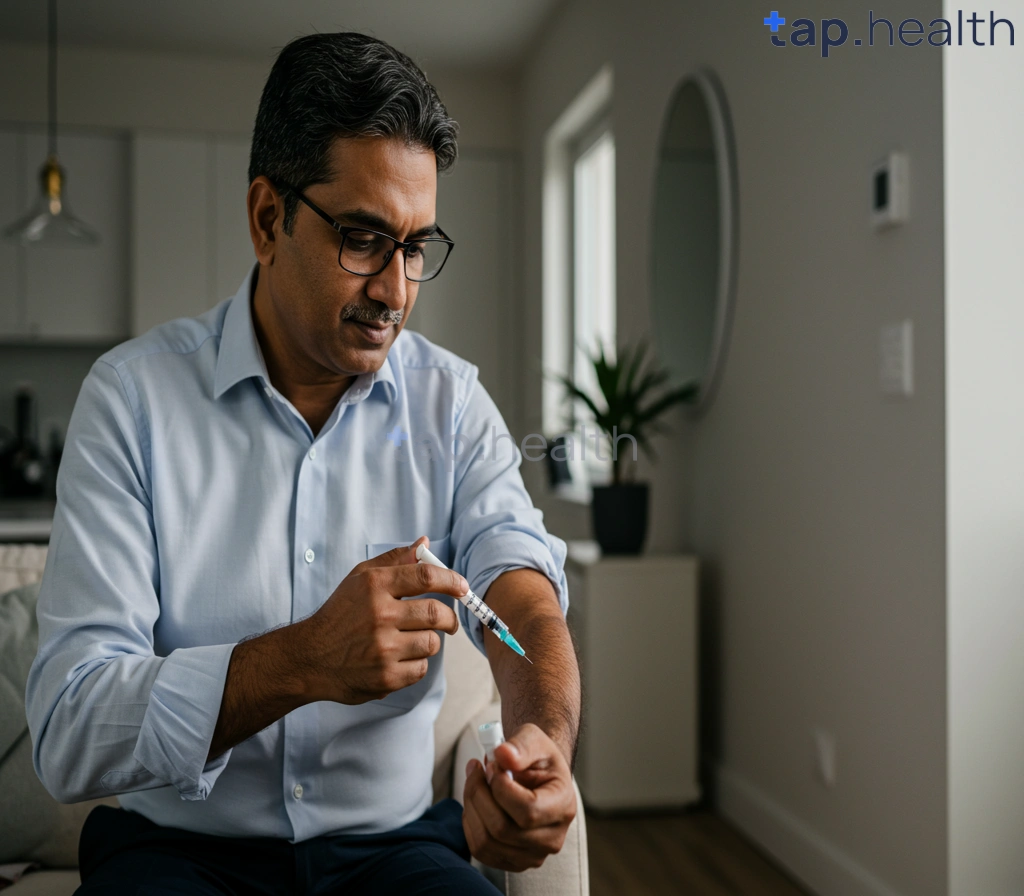Table of Contents
- Mastering Insulin Degludec Injections: A Step-by-Step Guide
- Understanding Insulin Degludec: Dosage, Administration & Side Effects
- Degludec vs. Other Insulins: Key Differences & When to Use It
- How to Properly Store and Handle Insulin Degludec
- Common Questions About Insulin Degludec Answered by Experts
- Frequently Asked Questions
- References
Managing type 1 or type 2 diabetes can feel like navigating a complex maze, but understanding your medication is the first step towards taking control. This guide focuses on Understanding Insulin Degludec: A Guide to Subcutaneous Injection, providing clear, concise information to help you confidently manage your diabetes. We’ll cover everything from proper injection technique to potential side effects, empowering you to feel more comfortable and in charge of your health. Let’s demystify insulin degludec together and make managing your diabetes a little easier. Ready to learn more?
Mastering Insulin Degludec Injections: A Step-by-Step Guide
Managing type 2 diabetes, especially prevalent in India and tropical countries, often involves insulin therapy. Given that over 80% of type 2 diabetics experience insulin resistance, understanding and mastering insulin degludec injections is crucial for effective blood sugar control. This guide provides a practical, step-by-step approach tailored to the specific needs of individuals in these regions.
Preparing for Injection
First, wash your hands thoroughly with soap and water. Then, carefully inspect the insulin pen and cartridge for any damage or cloudiness. Ensure the dose is correctly set on the pen. Choose an injection site – the abdomen, thigh, or upper arm – rotating sites with each injection to prevent lipohypertrophy (fat buildup). A clean injection site minimizes infection risk, especially important in warmer climates.
Administering the Injection
Gently pinch the skin at the chosen injection site to create a subcutaneous fat fold. Insert the needle at a 90-degree angle, pressing the injection button firmly and steadily. Hold the needle in place for a few seconds after injection before slowly removing it. Avoid rubbing the injection site after administering the insulin. Dispose of the needle safely and responsibly.
Post-Injection Care
Monitor your blood sugar levels regularly, as advised by your doctor. Keep a detailed record of your injections, including the date, time, dose, and injection site. Regular monitoring allows for adjustments in dosage and management strategy. In hot and humid climates, proper insulin storage is critical to maintain its effectiveness. For more information on improving insulin sensitivity, you might find our article on How to Improve Insulin Sensitivity with Diet and Exercise helpful. Consult your physician or pharmacist for specific guidance relevant to your region’s climate. Remember, consistent and proper injection technique is key to managing your diabetes effectively. Understanding the impact of diet is also crucial, and you can learn more about the effects of dairy and alternatives by reading our article on Dairy and Alternatives: Understanding Their Impact on Insulin Response.
Understanding Insulin Degludec: Dosage, Administration & Side Effects
Dosage and Administration of Insulin Degludec
Insulin degludec is a long-acting insulin analog used to manage blood sugar levels in people with type 1 and type 2 diabetes. Dosage is personalized and determined by your doctor based on your individual needs and blood glucose levels. Regular monitoring of blood glucose, ideally several times a day, is crucial. Remember, less than 140 mg/dL is considered normal, while 140–199 mg/dL indicates prediabetes, and 200 mg/dL or higher suggests diabetes. Your doctor will guide you on how to adjust your dose to maintain your blood sugar within the target range. Insulin degludec is administered subcutaneously, usually once daily at the same time each day. Common injection sites include the abdomen, thigh, and upper arm. Rotating injection sites helps prevent lipohypertrophy (accumulation of fat at the injection site). Proper injection technique is vital for effective absorption. Consult your doctor or a trained healthcare professional for detailed instructions on administering insulin degludec.
Side Effects of Insulin Degludec
Like all medications, insulin degludec can have side effects. Common side effects include injection site reactions (such as redness, swelling, or itching), hypoglycemia (low blood sugar), and weight gain. Hypoglycemia is a serious side effect that requires immediate attention. Symptoms can include sweating, shakiness, dizziness, and confusion. If you experience symptoms of hypoglycemia, follow your doctor’s instructions on how to treat it. In hotter climates prevalent in many Indian and tropical countries, it’s crucial to store insulin degludec properly to maintain its efficacy and prevent degradation. Always consult your doctor or pharmacist about the best storage practices in your specific region. Less common but potentially serious side effects include allergic reactions. Seek immediate medical attention if you experience any severe allergic reactions. Understanding the potential impact of insulin on other organs is also important. For example, you might find it helpful to read more about Does Insulin Affect Kidneys?
Conclusion
Managing diabetes effectively requires a comprehensive approach, including regular blood glucose monitoring, adherence to prescribed medication, and a healthy lifestyle. In India and other tropical countries, maintaining a balanced diet, staying hydrated, and avoiding extreme heat can significantly improve diabetes management. Remember to consult your doctor or a qualified healthcare professional for personalized advice on managing your diabetes with insulin degludec. They can help you understand the appropriate dosage, injection techniques, and potential side effects specific to your needs and living conditions. It’s also important to remember that insulin needs vary greatly depending on individual factors. If you’re not diabetic, for example, you may be wondering How Much Insulin Can a Non-Diabetic Take?
Degludec vs. Other Insulins: Key Differences & When to Use It
Understanding Degludec’s Unique Properties
Degludec insulin stands out due to its extended duration of action. Unlike rapid-acting or short-acting insulins, degludec provides a much longer-lasting blood sugar control, often lasting up to 42 hours. This is crucial for individuals in tropical countries, where fluctuating temperatures and lifestyles can influence blood glucose levels. For those struggling to maintain a fasting blood sugar level between 70–99 mg/dL, the prolonged effect of degludec can offer significant advantages. It’s especially beneficial for individuals with type 1 or type 2 diabetes who find it challenging to manage their blood sugar with other insulin regimens. This longer duration can mean fewer injections, improving adherence to treatment plans.
Degludec Compared to Other Insulin Types
Degludec differs significantly from other insulins such as regular insulin (short-acting) or NPH insulin (intermediate-acting). The prolonged action of degludec minimizes the risk of significant blood sugar fluctuations, which is particularly important in managing the challenges of diabetes in hot and humid climates. Remember, maintaining blood sugar levels within the normal range (70–99 mg/dL) is essential to prevent long-term complications. Individuals with prediabetes, whose blood sugar levels fall between 100–125 mg/dL, might also benefit from discussing degludec with their doctor as a preventative measure. Conversely, if your blood sugar consistently reads 126 mg/dL or higher, it’s vital to consult a healthcare professional immediately. For a better understanding of the potential consequences of insulin mismanagement, you might find our article on How Long Can a Diabetic Survive Without Insulin? helpful.
When to Consider Degludec
Degludec might be a suitable option if you experience frequent hypoglycemic episodes (low blood sugar) with other insulins, or if you struggle to maintain consistent blood glucose levels throughout the day and night. Its extended duration can simplify your insulin regimen, reducing the frequency of injections and making it easier to manage your condition, particularly beneficial in the context of busy schedules or challenging environmental conditions common in Indian and tropical countries. Always consult your doctor or an endocrinologist before making any changes to your diabetes treatment plan. They can assess your individual needs and determine if degludec is the right choice for you. Seeking expert guidance ensures optimal blood sugar management and improves overall health outcomes. It’s also important to understand the potential risks associated with insulin, even for non-diabetics. Learn more by reading How Much Insulin is Fatal for a Non-Diabetic?.
How to Properly Store and Handle Insulin Degludec
Maintaining Insulin Degludec Efficacy in Hot Climates
Insulin Degludec, a long-acting insulin analog, requires careful handling, especially crucial in hot and humid Indian and tropical climates. Improper storage can significantly impact its effectiveness and potentially lead to uncontrolled blood glucose levels. Remember, maintaining optimal blood glucose levels is vital; levels below 5.7% are considered normal, while 5.7%–6.4% indicates prediabetes, and 6.5% or higher suggests diabetes. Therefore, proper storage is paramount.
Storage Recommendations for Insulin Degludec
Always keep your insulin Degludec refrigerated (between 2°C and 8°C) until the expiry date printed on the pen or vial. Avoid freezing. Once opened, it can be stored at room temperature (below 30°C) for up to 42 days; however, in hotter climates, keeping it refrigerated for as long as possible is highly recommended. If you experience power outages, consider using a cooler with ice packs to maintain the temperature.
Handling and Injection Techniques
Before each injection, visually inspect the insulin. Avoid using it if you notice any cloudiness, discoloration, or particulate matter. Always inject your insulin subcutaneously (under the skin) as instructed by your doctor. Rotate injection sites to prevent lipohypertrophy (fat buildup). Remember to keep the insulin pen or vial clean and dry.
Seeking Expert Advice in India and Tropical Countries
In India and other tropical regions, the high temperatures can pose a significant challenge to proper insulin storage and management. Consult your doctor or pharmacist regularly for personalized guidance on storing and handling your insulin Degludec to maintain optimal blood sugar control. Don’t hesitate to seek clarification on any aspect of your treatment plan. Your health is paramount, and proper insulin management is key to a healthy life. Managing diabetes effectively also involves considering other health factors. For example, learning how to manage cholesterol levels with diabetes is crucial for overall well-being. Furthermore, understanding how to safely enjoy alcohol while managing diabetes can contribute to a better quality of life.
Common Questions About Insulin Degludec Answered by Experts
What is Insulin Degludec and How Does it Work?
Insulin degludec is a long-acting insulin analog used to manage blood sugar levels in adults with type 1 or type 2 diabetes. Unlike some other insulins, it provides a consistent, extended release of insulin into your bloodstream, helping to maintain stable blood sugar levels throughout the day and night. This is crucial for managing hyperglycemia, particularly in tropical climates where fluctuating temperatures and humidity can impact blood sugar control. Understanding its extended action is key to proper meal planning. For example, if you consume a meal containing 45-60 grams of carbohydrates, as often recommended, the consistent insulin release from degludec helps prevent post-meal spikes.
How is Insulin Degludec Administered?
Insulin degludec is administered subcutaneously, meaning it’s injected under the skin using a pre-filled pen or syringe. Proper injection technique is vital for effective absorption and to prevent complications. It’s important to rotate injection sites to avoid lipohypertrophy (thickening of the skin at the injection site) – a concern particularly prevalent in warmer climates due to increased sweating and skin irritation.
What are the Potential Side Effects of Insulin Degludec?
Like all medications, Insulin degludec can have side effects, though these vary from person to person. Common side effects include injection site reactions (redness, swelling, itching), hypoglycemia (low blood sugar), and weight gain. It’s crucial to discuss any concerns with your doctor or diabetes educator, especially considering the impact of climate on medication efficacy and side effect manifestation in Indian and tropical countries. Regular monitoring of blood sugar levels is essential to manage these potential side effects effectively.
Where Can I Learn More About Managing My Diabetes in India/Tropical Climates?
Managing diabetes requires a holistic approach, including diet, exercise, and medication. Consult your doctor or a certified diabetes educator to create a personalized diabetes management plan tailored to your specific needs and the climate you live in. They can provide guidance on carbohydrate counting (remembering the suggested 45-60 gram range per meal as a starting point), appropriate exercise routines, and medication management in your region. For more information on insulin dosage, you might find What Is The Average Dose Of Insulin For Type 2 Diabetes? – Tap Health helpful. If you’re interested in learning more about non-insulin dependent diabetes, we recommend reading What is Non-Insulin Dependent Diabetes?
Frequently Asked Questions on Insulin Degludec
Q1. What is insulin degludec and what are its benefits?
Insulin degludec is a long-acting insulin analog used to manage type 1 and type 2 diabetes. A key benefit is its extended duration of action (up to 42 hours), simplifying treatment regimens and potentially improving adherence compared to other insulin types. This is particularly helpful in hot and humid climates.
Q2. How do I properly inject insulin degludec?
Proper injection technique is crucial. Use the subcutaneous route and rotate injection sites to prevent lipohypertrophy (fat buildup). Consult your doctor or pharmacist for detailed instructions and demonstrations.
Q3. What are the potential side effects of insulin degludec?
Like other insulins, degludec can cause side effects such as hypoglycemia (low blood sugar) and injection site reactions. It’s important to monitor your blood glucose regularly and report any concerns to your healthcare provider.
Q4. How should I store insulin degludec, especially in hot climates?
Proper storage is essential to maintain insulin efficacy. Store insulin degludec as directed by your doctor or the product labeling, paying close attention to temperature guidelines. This is especially important in hot and humid conditions.
Q5. What is the role of my healthcare provider in managing my insulin degludec treatment?
Your healthcare provider plays a vital role. They will help determine the correct dosage, create a personalized management plan tailored to your needs and environment, and provide ongoing support and guidance. Regular check-ups and open communication are critical.
References
- A Practical Guide to Integrated Type 2 Diabetes Care: https://www.hse.ie/eng/services/list/2/primarycare/east-coast-diabetes-service/management-of-type-2-diabetes/diabetes-and-pregnancy/icgp-guide-to-integrated-type-2.pdf
- Children with Diabetes : A resourse guide for families and school. : https://www.health.ny.gov/publications/0944.pdf



